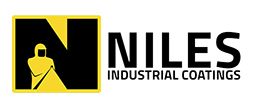Niles industrial coatings reduces dust exposure for employees
The use of silica product in abrasive blasting has increasingly become more of a safety risk for construction workers. Exposure to too much respirable crystalline silica causes serious health problems such as lung cancer, silicosis, chronic obstructive pulmonary disease and kidney disease. As a result, we have seen new regulation in the industry with the OSHA Silica Rule, which limits the permissible exposure limit (PEL) to silica.
One way companies are protecting their workers is by making a switch from dry blasting to wet or ‘vapour abrasive’ blasting. Vapour abrasive blasting is similar to dry blasting except the blast media is moistened prior to impacting the surface, resulting in a significant reduction in dust exposure. NILES Industrial Coatings, in search of a solution for reducing its employees’ exposure to silica, found recent success with Graco’s EcoQuip.
Versatile equipment
NILES uses EcoQuip vapour abrasive blasting equipment for a variety of applications across several industries including oil terminals, dams, automotive facility maintenance, petrochemical, power, structural steel, and tank linings. They also work with large farm and construction equipment companies. Their clients often look to them for best practices in the latest technology and many of them have been pleased with the results they’ve seen from EcoQuip.
Reduced air containment problems
A key advantage that NILES discovered while using vapour abrasive blasting was less air containment issues. Firstly, there is less of a need to require the use of full fresh air supplied suits for the blasters when the majority of airborne dust is suppressed. Secondly, it is far easier to contain dust with vapour abrasive blasting since the water/media mixture stays nearby and falls to the ground more easily. Thirdly, job clean-up is also reduced and simplified.
Less maintenance
NILES also discovered there is less maintenance on vapour abrasive equipment versus dry blasting machinery. The controls and valves on dry blasters wear out more quickly because hot air from the compressor is flowing through all the control points and dry media easily abrades the media control valve, whereas vapour abrasive blasting machines only rely on air for the blast power and blast on/off control. Blast hoses can typically last twice as long when using vapour abrasive blasters because the wet media is cooler and reduces friction in the hose compared to dry blasters.
Easier mobilisation of equipment
When using EcoQuip on the jobsite, NILES employees can mobilise and demobilise their equipment a lot more efficiently since the machine uses a 2-ply hose, which is lighter and easier to manoeuvre than the larger 4-ply hose typically used with their dry blast equipment. This is a big advantage for their employees operating at heights, such as working off scaffolding.
Mobilisation is also easier because of the reduced need to set up containment before each project. Large air dryers are also not needed when using vapour abrasive blast equipment because the media is already wet in the pot.
Reducing medai usage up to 50%
As a result of using six EcoQuip units regularly, NILES has seen a successful reduction in water and media usage, fewer air containment issues, and significantly lower clean-up costs. They also cite fewer delays due to weather, when compared with the dry blasting process, because of the ability to blast in wet or rainy conditions.
"When we switched over to EcoQuip we found our media usage reduced by 50 per cent," said Craig Brooks, Key Accounts Operations Manager, NILES Industrial Coatings. "Another big advantage is the amount of water we save since we’re no longer using a more traditional halo nozzle. We typically use half the water we’d regularly use when using a halo nozzle. On average our overall containment costs with EcoQuip are reduced by 90 per cent, and our clean-up costs are reduced by 30 to 40 per cent."
- LESS Containment
Containment systems cost your business time and money. Use a vapor abrasive blasting machine if you’re looking for increased efficiency and to spend less time assembling, disassembling and moving containment systems around a job site. - LESS Water
Vapor abrasive blasting uses less than a quart of water per minute, which is a lot less than WIN and Halo nozzles that attempt to wet the high velocity dry media as it exits the nozzle. With vapor abrasive blasting, since the media is already wet, the only water discharged is that which exist between the particles of wet media being pushed into the blast circuit. Precise control of that media typically results in both low water and media usage. - LESS Weight
Make life on the job site easier with lighter and more flexible hoses whenever possible. Vapor abrasive blasting uses wetted media, reducing friction, so you get longer life from a light weight, 2-ply blast hose. Less weight over long hose lengths makes them ideal for workers operating at high elevations. - LESS Maintenance
Thanks to the addition of water, vapor abrasive blasting machines produce less friction and heat in the blast circuit, hoses and nozzles. This results in far less maintenance on the machine as well as two times the life of the blast hose compared to tradition dry blasters. - LESS Health Risks
Protect your employees from dangerous health risks by reducing the exposure to airborne dust that could contain silica.

related articles
Asbestos removal through vapour abrasive blasting
Vapour abrasive blasting can be used for asbestos removal, but only under certain conditions.
Abrasive blasting checklist: what you need to do to prep and clean up a job site
This blasting checklist guarantees the perfect preparation for all wet and vapour blasting operations
How to blast fibreglass hulls without damaging the gel coat
Removing the antifouling paint from a fibreglass hulls is easy with vapour abrasive blasting
